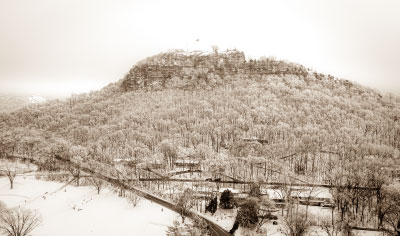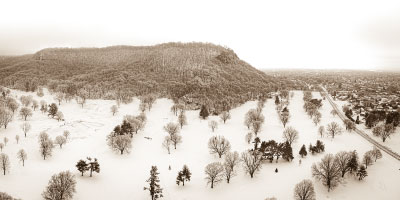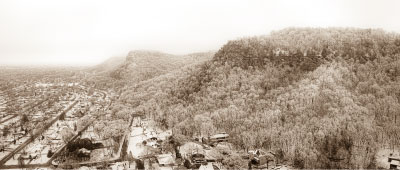With the arrival of winter in Wisconsin, the deep ravines and rocky contours of the bluffs in the Driftless Area can be clearly seen. Many folks like to say that one can now see “bones of the land”. Clearly visible too, are the “arteries of the land”, the rivers, roads, and railroads which pass through or wind around those bluffs.
As snow accumulates, a stillness descends on the bluffs. They become a tranquil sensory oasis. The coulees are silent except for the occasional scurrying squirrel, the call of a bird, or one’s footsteps. From our home, at the foot of a line of bluffs, we can look out of our front windows and see the intersection of a busy state highway, a pair of railroad tracks, and a broad backwater of the Mississippi River. We have come to think of the bluffs outside of our back door as welcoming, silent, benevolent sentinels – witnesses of, and participants in, the rich history of the Driftless Area.
The aerial portraits accompanying this article show the benevolent sentinels on a cold winter morning shortly after receiving a rime ice covering. They are reduced versions of large format gigapixel panoramas, each created from 15 to 30 high-resolution captures. Each image has been digitally toned with a custom process to create the look of vintage sepia prints – a fitting style of presentation for these ancient friends.
Ancient Witnesses

The bluffs, which border the ever-changing channels of the Mississippi River, were carved over eons by the flow of that mighty river and its tributaries. From the times of early indigenous peoples to the settlements of the first European immigrants, human activity has marked the bluffs. Many of the winding trails through their coulees and the scenic roads atop their ridgelines began as ancient human routes. These bluffs are both natural wonders and recorders of human history.
Cities along this stretch, like La Crosse, Wisconsin, are quite literally built from the stuff of these bluffs. Granite harvested from quarries has been used to shape everything from gravel roadbeds to grand mansions. In a marriage of natural creation and human recreation, local quarries have been converted into havens for outdoor enthusiasts, offering opportunities for hiking, biking, rock climbing, and wildlife viewing. Over time, increasing numbers of people have come to value these bluff lands as more than a source of raw material. As a result, ever-increasing amounts of acreage have been set aside to create places that are both beneficial to human flourishing and dedicated to the preservation of and development of new natural spaces.
Winter Transformation

The bluffs are lush in the summer and brilliant in the fall. With the wintertime blanketing of their slopes, a relatively soundless transformation takes place. Snowfall paints the landscape in broad, brilliant white strokes. Trees trade their leaves for a delicate coat of snow. Bluff faces are dusted with a powder that accentuates their majestic forms. A calm and quiet atmosphere arrives in the coulees.
As each fresh, pristine layer of snow accumulates, the air in the coulees becomes crisper and a winter quiet descends upon the landscape. The nearby Mississippi River and backwaters undergo a similar transformation, becoming a lowland echo of the upland wintry scene. Waters freeze. Winds carve the snow cover into interesting shapes. On many days, the snowy silence on the river is broken only by the occasional creak or groan of the ice beneath as the air temperature rises and falls.
Winter Wildlife and Outdoor Adventure

In this winter wonderland, wildlife watchers will find a very diverse and active cast of characters carrying out their daily activities along bluff ridges, slopes, and valleys. White-tailed deer, rabbits, tree squirrels, coyotes and the occasional bobcat or ermine can be seen. Birds of prey, game birds and songbirds soar above the ridges or flit along bare branches.
Adventure seekers can explore a wide variety of winter activities. Hiking trails are transformed into snowy corridors. Clearings in stands of pine become hushed natural cathedrals. Snowshoeing adds new dimensions to winter walks, offering the option of a peaceful stroll through a lowland wooded trail or a high-intensity workout on an aggressive slope. Those who like to live life on two runners will find venues for cross-country and downhill skiing, skate-skiing, ice skating, sledding, and even horse-drawn sleigh rides. Lower slopes offer opportunities for family fun on toboggans, inner tubes, saucers and even low-tech sleds made of cardboard boxes.

The winter fun continues even after the sun goes down with community celebrations like Rotary Lights along the Mississippi River in La Crosse, the welcoming beacon of the lighted tree atop Grandad Bluff, candlelight hikes through Hixon Forest, and skating at local rinks. In the snowy heart of winter, the bluffs beckon us to explore, breathe in their tranquil air, and enjoy the view. From the river to the ridge tops, the Mississippi River bluffs offer a sanctuary for those who seek adventure, solitude, and the timeless beauty of the winter season.
Writing and Photography By: Mark F Devine



